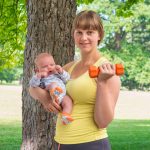
Most people respond to life changing events with a mix of excitement, hesitation and anxiety. And let’s face it, having a baby is one of the biggest life changes one can face! Luckily, there are quiet restorative yoga poses and pranayamas (breathing exercises) that help quiet the mind, balance the breath and relax the body. Also, the anxiety of having a baby has many women up at night with their minds racing about the hundreds of different things to be done before baby arrives. The pranayamas exercises can be a helpful tool to quiet the vrittis (fluctuations of the mind) and help the mama-to-be to fall back asleep.
Restorative Yoga Poses
One of the greatest benefits of restorative poses is that they offer the mother time to be with her baby, listen to her baby and to her own body and, if anything, the opportunity to gain a greater understanding of her inner thoughts and feelings.
Two of my favorite prenatal restorative poses are Supta baddhakonasa (Reclined Goddess Pose) and Supported Child’s Pose.
Supta baddhakonasa (Reclined Goddess Pose) is done by setting up two blocks under a supportive bolster and rolling a blanket or towel up. The mother then places the soles of her feet together, allowing the knees to fall to the side and wraps the blanket or towel underneath her ankles and shins to support her legs. She then brings her lower back right up against the bolster and gentle reclines herself back. It is important to make sure there is no gap between the bolster and the lower back. She can also place another blanket or towel at the top of the bolster if she feels her head is leaning to far back.
I also like to sometimes add an eye pillow or head wrap to restorative poses to help relax the eyes and deepen relaxation poses. By covering the eyes or even adding the gentle weight of an eye pillow promotes releasing tension of the muscles around the eyes and promotes the withdrawal of the outer senses which can help the practitioner focus more inwardly.
One contraindication of supta baddhakonasa is mothers with sacro-iliac joint pain. The deep hip opening can aggravate this situation. Those mothers can still enjoy the recline of the pose but should opt to put the rolled blanket or towel under the knees of two straight legs instead of bringing the knees to the side.
Supported Child’s Pose can be great for relieving lower back pressure and also helping to facilitate a good fetal position for baby since mom is resting with her belly facing downward. This pose is done by propping a bolster up on two blocks to create an upward sloped angle. The mom then comes onto her shins, open her knees wide and brings her feet together and rests forward onto the bolster. There are no contraindications for this pose.
Pranayamas
Pranayamas is the art of breath control. Certain ones can be very invigorating and heating while others can be calming and cooling. Either way, it requires focus of the mind on the breath. This focus can help quiet the mind and still the vrittis to help the practitioner be more present and still. While pranayamas are not meant to lull someone to sleep, I have found this practice particularly helpful to quiet my mind on nights I suffer from anxiety produced insomnia.
Sama vritti pranayama (even fluctuation of the breath) helps bring balance and calmness to the mind. It is done inhaling and exhaling for equal lengths For example, inhaling for 4 counts and exhaling for 4 counts. If you notice the mind wondering as you are counting the breath, simply try to release the thoughts and come back to your counting.
Viloma (three part breathing) is believed to help bring clarity and lightness to the body and mind. It is typically done with breath retention. But during pregnancy, we leave that part out and focus more on filling and expanding the lungs and ribcage. To do this pranayama, simply visualize three parts to the upper torso region, the base being the bottom of the lungs and ribcage, the middle being the mid-ribcage and the upper being the upper ribcage and lungs all the way up to the collarbone. As you inhale, focus on filling each area fully, when you feel like you hit capacity, slowly releasing the breath. Take a few unconditioned breaths and repeat.
I hope that by incorporating these poses and breath exercises into your daily life, anxiety, stress and an over active mind can start to be a thing of the past.
Like what you read? Sign up for our free newsletter so you can be informed of the latest FREE webinars & teleclasses, parenting articles, & weekly raffles.
*Disclaimer- not meant to take the place of medical advice.
Debra Flashenberg, CD(DONA), LCCE, E-RYT 500 is the director of the Prenatal Yoga Center. She has spent most of her life performing and was introduced to yoga through a choreographer in 1997. After several years as a yoga student, she decided to continue her education and became certified as a Bikram Yoga instructor. After being witness to several “typical” hospital births, Debra felt it was important to move beyond the yoga room and be present in the birthing room. In 2006, Debra received her certification as a Lamaze® Certified Childbirth Educator. In September of 2007, Debra completed a Midwife Assistant Program with Ina May Gaskin, Pamela Hunt and many of the other Farm Midwives at The Farm Midwifery Center in Tennessee. Drawing on her experience as a prenatal yoga teacher, labor support doula and childbirth educator, Debra looks to establish safe and effective classes for pregnancy and beyond. She is the proud (and tired) mother of new baby boy, Shay.
* Healthy Living is section of our website co-hosted by Lemi Shine. Lemi Shine has compensated Mommybites to be a partner in this awesome Healthy Living section on our website. This partnership does not influence the content, topics or posts made on this blog. We always give our honest opinions, findings, beliefs, or experiences on all topics, products, and services.



